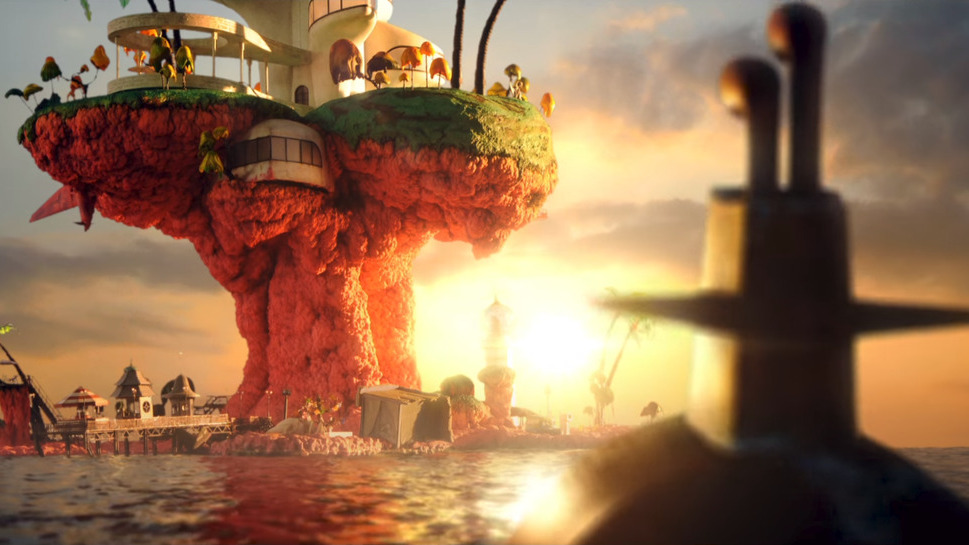Photographers all know about polarizing filters. They remove reflections off the surfaces of objects. We use them to see into water or windows that are obscured by those reflections. But anything with an even slightly glossy surface has a layer of reflection on top. So if you have a shiny green plant, it can remove the shiny and reveal a very saturated green underneath. Polarizers also remove a lot of scattered and reflected light from the sky. Which reveals a deep blue color you didn't even know was there.
Here is a photo I took of my circular polarizer.
And the first thing I noticed when walking outside during the eclipse was the color of everything was more saturated, just like in that circle. Apparently, an eclipse significantly reduces polarized light and I got this creepy feeling because I was only ever used to seeing the world like that through the viewfinder of my camera.
The other thing I noticed was my outdoor lights. I leave them on all the time because I never remember to turn them on at night. And usually the sun will render them barely visible during the day. On a very sunny day they almost look like they are off.
But you can clearly see they are shining and even flaring the camera during the eclipse.
Our eyes adjust to lighting changes very well so it was hard to tell how much dimmer things were, but that is a good indication. I took this photo a few minutes ago and you can see how dim the lights appear after the moon has fucked off.
I did a calculation using the exposure settings between these two photos. The non-eclipse photo has 7 f-stops more light. That is 128 times or 12,700% more light.
A partial Pringle eclipse cut the sun's light by 99.2% and somehow our eyes adjusted to make it seem like a normal sunny day (with weird ass saturated colors).
Additional Observations
So, I woke up about 4 minutes before the eclipse. I was very unprepared to photograph it in the normal quality you'd expect from a photographer. However, I did capture some interesting details that I thought I'd share beyond the lack of polarized light.
First up... the shadows.
The shadows were very sharp. In photography there is this concept of light going from a spectrum of hard to soft. Hard light has very high contrast and sharp shadows. Soft light is more flattering and diffused with softer shadows.
To get hard light and sharp shadows you need a small "point" light source. A point light can either be very small or it can be very far away or a combination thereof.
In the studio you could use a bare bulb flash to get a point source.
Or you can attach a modifier like a softbox to create a large light source. The bigger, the softer.
The sun is massive, but it is also super duper far away. So it ends up being the smallest point light source available. However, the atmosphere can scatter and diffuse that light, essentially "enlarging" the light source.
To get perfect hard light shadows you need to go to... the moon.
But the eclipse blocked out about 99% of the sun and it reduced the amount of scattered light. And it greatly reduced the size of the light source causing some very defined sharp shadows.
But not *all* of the shadow was sharp. My left shoulder is very defined but my right shoulder is a bit fuzzy.
You can see it on my fingers too.
Sharp on one side, soft on the other.
This is essentially because the sun has been split into two different light sources in two different directions.
In one direction you have a larger light source causing softer shadows.
And in the other direction you have a smaller light source causing sharper shadows.
In photography we have these strip softboxes that we usually place behind a subject to create an edge light.
Only a narrow, small band of light is hitting the body. If we were to use a strip box to light a face, it would be a small light source creating sharp shadows.
But one trick we can do is to turn the strip light horizontal.
Now the light source hitting the face is large as it wraps around the head.
So a long and narrow light source is essentially large and small simultaneously. And depending on the direction the light is coming from it is either hard or soft light.
Destin from Smarter Every Day explained this phenomenon briefly in his eclipse video.
I also think this large and small light source phenomenon affected my lens flares when I photographed the sun.
In this photo it literally looks like I'm getting starburst flares from two light sources.
And in this photo the flares have a sharp bright edge as well as a dimmer more diffused area.
Normally these starburst flares (caused by light leaking through the metal aperture blades in the lens) have more homogenous tines without that feathering effect.
And then I noticed a different kind of flare in my photos—with all the colors of the rainbow.
And each band of color matched the crescent shape of my partial eclipse.
Like a camera obscura, these flares were in reverse orientation to the crescent sun. And while I wasn't able to get the sun in sharp focus, the purple section of the flare is very defined. I think that represents approximately how much of the sun was covered by the moon at my location—about 130 miles from totality.
I am a student of light. That is essentially what photography is. And I found this to be a fascinating lesson on how bonkers light can be. I was a little bummed I couldn't road trip to southern Missouri to see totality, but I am grateful to still have a cool eclipse experience.


